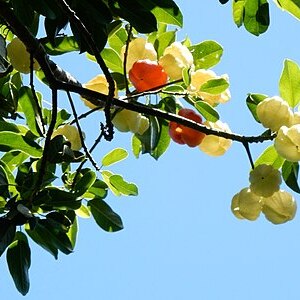A small tree. It grows 6-12 m high and spreads 3-8 m across. The crown is compact. The bark is grey-brown with slight furrows. The young growth is bright green and shiny. The leaves are 6-15 cm long by 2.5-6.5 cm wide. They are broadly oval. The leaf stalks are slender and 2-8 cm long. The flower panicles are at the ends of branches. The flowers are separately male and female. The flowers are 2 cm across. Each female flower occurs without a stalk and with 2 male flowers on stalks on either side. The fruit are dry. They are enclosed in a fleshy cover. They are 1.5-2 cm long by 1.5 cm wide. The seed is 2 cm across and hard.

